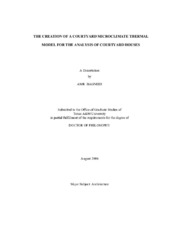| dc.description.abstract | This research is an effort to revive the use of courtyard housing clusters in a modern
context, which were traditionally known for their distinctive passive cooling
performance. The goal is to promote energy efficient design in hot-arid climates and
temperate climates by reviving the use of courtyard housing clusters.
The objective is to introduce a simplified thermal model that simulates the
courtyard microclimate, which has been tested with actual field data from a case study
house. The case study house was an indigenous courtyard house in Cairo, Egypt that
was built around 1400 AD, having an area of about 5000 sq. ft. (i.e., comparable to the
size of a single-family house) with heavy thermal mass. To accomplish this, a finite
difference thermal network model was created for simulating the case study courtyard
microclimate. The finite difference (FD) model showed validity as it calibrated very
well against field data. This model allowed running parametric sensitivity studies on
the courtyard thermal simulation factors: air change rates, thermal mass, solar
absorption, wall and floor emissivity, ground temperature, cloud cover, and ambient air
temperature. The results of the parametric analysis showed that the model was
sensitive to variations in the air change rates, solar absorptivity, and ambient air
(rooftop) temperatures.
The courtyard microclimate model was then used in combination with thermal
simulation software (DOE-2) to analyze the thermal performance of the case study
house, which was also validated with measured field data. The DOE-2 program showed limitations when applied to the case study, non-conditioned building, and showed a
convergence deficiency when simulating high thermal mass buildings. The DOE-2
program did not perform well in simulating the impact of changes in thermal mass as
compared to previous published field measurements. The proposed combinations of the
FD microclimate/DOE-2 simulation did not perform as well as the FD microclimate
simulation.
The FD courtyard microclimate simulation model with onsite data for calibration
is advantageous in introducing for the first time the ability to perform computer
simulations on any number of proposed courtyard design alternatives for reaching
optimum thermal performance. | en |


